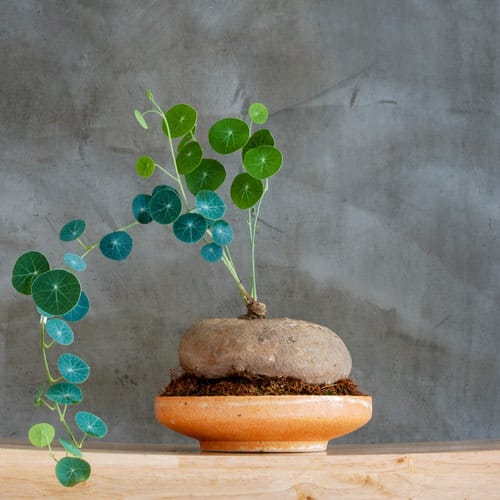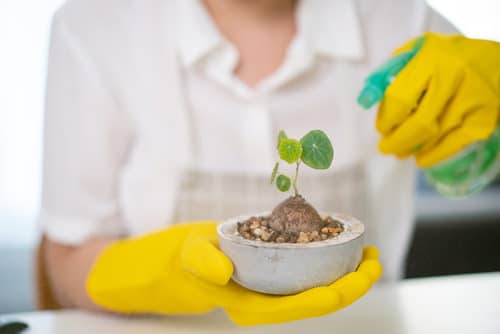This article contains all the essential planting, caring, and Stephania Pierre Growing Information that will help you have your own!

This Stephania Pierre Growing Information guide will teach you everything about pot size, compost, watering, planting care, and more!
Botanical Name: Menispermaceae
Original Name: Stephania erecta until the early 1920s
Care Difficulty: Moderate to Difficult
USDA Zones: 10a-11b
Have a look at the detailed growing information on cascara tree here
Stephania Pierre Growing Information
Stephanias are native to the Australasia region and Southeast Asia, especially the Indochinese nations. The caudex plant is typically found in the seasonal deciduous forests in their natural habitats on limestone mountains.
Stephanias need well-drained soil, full sunlight, good air circulation, and not too humid conditions to grow well. Once the growing season begins in spring, the plant needs a moderate amount of watering, and bright light to thrive well.
Propagation Method for Stephania Pierre

The best method to propagate Stephanias is by purchasing its bulb from a local nursery, garden center, or ordering it online. You can also propagate it by seeds but it’s a time-consuming process.
- Commonly known as the ‘bulb,’ but actually, it is called a caudex. It looks like a brown ball and might confuse a lot of first-time plant growers!
- Before you plant it in a pot, you have to prepare the bulb for growing in a process termed as ‘Waking up the bulb.’ What you have to do, is to keep the bulb in a bowl of water for 24 hours, making sure you have submerged the bottom part (the part having the ‘nodes’ or the circular ring is the top one). This will ensure that it becomes soft and gets ready for propagation.
- Plant the bulb in a pot filled with a cactus or succulent mix. Do not forget to layer the bottom of the pot with stones.
- Do not push the bulb in the pot. Instead, fill the pot halfway with soil, keep the bulb and then fill the potting mix again till it covers the lower 2/3 of the bulb.
- It is a good idea to fill a thin layer of compost on the top. Water the medium well and keep the pot where it can get bright, indirect sunlight.
- Be patient! The bulb will take its own sweet time to form roots.
Right Container for Growing Stephania Pierre
You can choose a decorative container with enough drainage holes. Using a terracotta pot over ceramic or plastic is most recommended because it helps in absorbing moisture and also offers a contrasting look. An 8-10 inches container will be more than enough.
Growing Requirements of Stephania Pierre
 Location
Location
Direct sunlight will do wonders for the growth of the plant but you will also have to care that it is not exposed to the harsh sunlight. The best location would be an east-facing window where it will bask in the morning sun for 2-3 hours. Avoid keeping it in a dark location.
Soil
Do not use regular garden soil or potting mix. The plant thrives best in a growing medium designed specifically for succulents and cacti.
Watering
The best way to water the plant is to leave the soil a little on the drier side between watering. Check the topsoil with your finger and water the plant only when it feels dry. Avoid overwatering as it will result in wilting, yellowing, and browning of leaves.
Humidity
The plant loves humidity and it would be a great idea to keep the pot on a tray filled with water and pebbles. Misting the foliage from time to time will also help to raise the humidity levels around the plant.
Temperature
The plant does best in the temperature range of 61-79 F (16-26 C). Avoid exposing the plant to 59 F (15 C) or lower as it will cause severe damage.
Get the best tips to grow Hoya Kerrii indoors here!
Stephania Pierre Care

Fertlizer
If you are using a potting mix designed for cacti, then you don’t have to fertilize the plant on a regular basis. Fertile it twice a year in the summer and autumn period using a feed recommended for cactus. Do refer to the label for dosage and instructions. Avoid feeding the plant in winters.
Pests and Diseases
Be careful about aphids, thrips, spider mites, whitefly, and mealybugs. They can be taken care of by using insecticidal soap. Avoid overwatering the plant to avoid most of the diseases.
Pruning
Using a pair of clean, sharp scissors or pruners, remove yellow or dying leaves from time to time. This will promote healthy growth and will also lower the chances of any bacterial or fungal diseases.
Fan of Petunias? Check out our article on growing Night Sky Petunias here!
Winter and Spring Dormancy Care
Reasonable care will ensure the bulb regains its strength for the next season. Cut back on watering and place it in a darker space until there are new signs of leaves. Maintain a dry, warm condition during this period.
After the dormancy ends, you can gradually increase the temperature by moving it to a brighter spot to encourage new growth. Water the plant thoroughly and wait for 4-6 weeks for the signs of change.
Here’s everything you need to know about growing Raspberry in pots!
Toxicity
Ingestion of its leaves may cause vomiting and nausea. It would be a good idea to keep it out of reach from children and pets.
Stephania Pierre Uses
The most popular six species of Stephanias are Cocculus hirsutus, Stephania japonica, Stephania glabra, Tinospora crispa, Tinospora cordifolia, and Tinospora Sinensis.
Out of the six species, Tinospora cordifolia and Stephania japonica are most commonly used to treat diabetes, pain, bone fracture, edema, debility, respiratory tract disorders, helminthiasis, gastrointestinal disorders, malaria, tuberculosis, hepatic disorders, urinary tract disorders, measles, and hypertension. The folk medicinal use of many of these plants has been validated via scientific researches.


